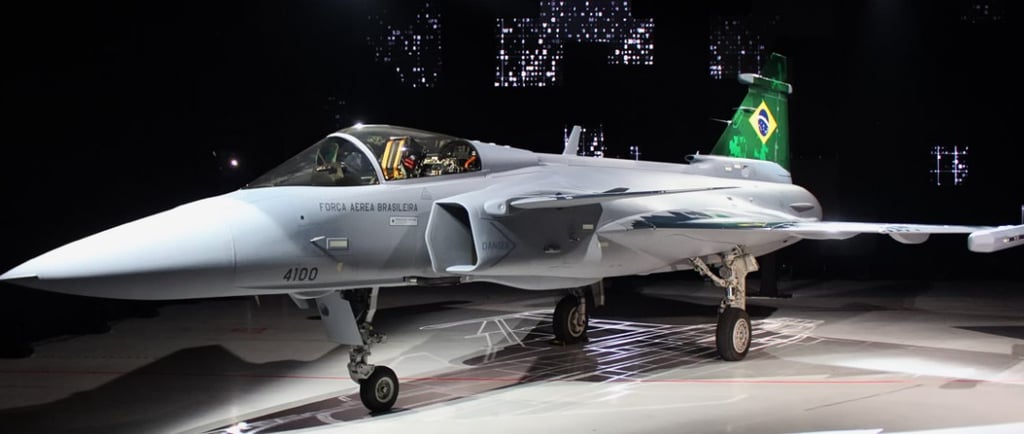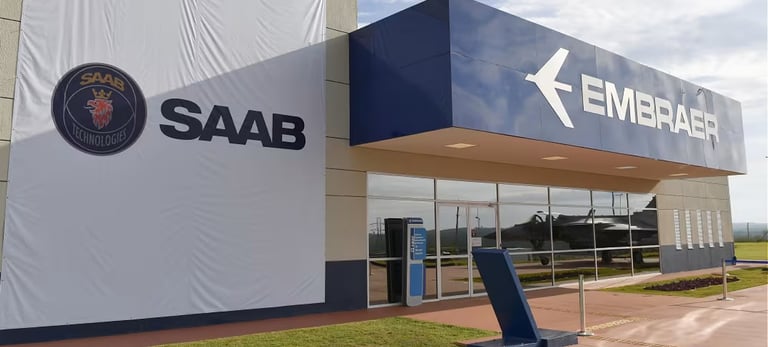Brazil Takes Flight: The Gripen E, Ushering in a New Era for National Defense
Brazil Takes Flight: The Gripen E, Ushering in a New Era for National Defense. Brazil has just written an unprecedented chapter in its industrial and strategic history: the first CA Gripen E fighter jet, entirely manufactured on national soil, is finally ready.
NEWS
Unveiled Brazil
5/26/20255 min read


This achievement isn't just an industrial victory; it's a strategic leap that redefines the country's position on the global military stage. But what exactly makes this fighter so special?
The Gripen E belongs to the 4.5 generation, placing it alongside renowned aircraft like the French Rafale and the Eurofighter Typhoon. While not a fifth-generation fighter like the F-35, it integrates cutting-edge technologies that rank it among the most modern operational jets worldwide. And most impressively, a significant portion of this sophisticated machine was built right here, deep in São Paulo state.
Behind the Scenes: The Strategic Choice that Changed Everything
Few are aware of the intricate drama that unfolded, leading to the Gripen's selection. There were political upheavals, intense international lobbying, a rejected multi-billion dollar French proposal, and a commercial "cold war" that culminated in a transformative agreement. In 2013, the Brazilian government stunned the world by announcing the Swedish Saab Gripen E as the winner of the FX-2 program. The competition was fierce, with industry giants like Dassault's Rafale and Boeing's F/A-18 Super Hornet vying for the contract.
The Gripen's victory was rooted in a clear advantage: real technology transfer. More than just buying aircraft, Brazil demanded knowledge. The goal was to absorb the technology, learn to manufacture, adapt, test, and, in the future, develop independently. Sweden embraced this challenge. France, despite a last-ditch effort to partner with Brazil and reducing its price by $2 billion, couldn't guarantee the same level of transfer. Saab offered a genuine partnership; others merely offered a sale. Thus began one of the most ambitious projects in Brazilian Air Force history: not just operating modern fighters, but building them at home.
A Factory on Brazilian Soil: A Landmark of Sovereignty
The production of the Brazilian Gripen E takes place in Gavião Peixoto, São Paulo, at the Embraer plant, a company also deeply involved in the engineering and assembly. This is the only Gripen production line outside of Sweden, a testament to both Sweden's commitment and Brazil's growing capabilities. In May 2023, the factory was officially inaugurated. Since then, Brazil has begun integral assembly of 15 of the 36 contracted aircraft.
This assembly process is far from symbolic. The structure comprises four main sections: forward, aft, center fuselage, and armament unit. All 35 km of cabling are installed here, along with electronic systems, engines, radars, and finally, the operational camouflage. This undertaking is supported by two strategic centers located in Brazil: the Gripen Design and Development Network (GDDN) and the Gripen Flight Test Center (GFTC). Brazilian engineers actively participate in adapting the fighter to the country's specific realities, considering climate, topography, infrastructure, and mission types. Crucially, this technology remains in Brazil, available for reuse in future aircraft, modernizations, drones, or other defense projects.
The current forecast indicates that the first Gripen assembled in Brazil will be delivered in 2025, with two more already in the production line. Once all are complete, Brazil will possess not only 36 operational fighters but also an unprecedented industrial capacity in the Southern Hemisphere.
What Makes the Gripen E So Special? Unveiling Its Advanced Capabilities
Known as the F-39 by the Brazilian Air Force, the Gripen E is more than just an evolution of the original model; it's a technological leap within the 4.5 generation. While maintaining the general shape of the Gripen C/D, every critical component has been upgraded: sensors, engine, avionics, structure, and electronic warfare capabilities. It is, effectively, an aircraft with a "digital brain, reinforced muscles, and long-range electronic eyes."
Engine Power: It utilizes the GE F414G, a version of the US F414 engine (also found in the Super Hornet), delivering approximately 22,000 lbf of thrust, sufficient power to reach speeds exceeding Mach 2.
Advanced Avionics: Equipped with a sophisticated suite of sensors and computers capable of processing thousands of data points in real time. Pilots no longer need to interpret a flood of signals; the system automatically fuses data and displays only relevant information on a panoramic touchscreen display, resembling a giant tablet, enabling swift and precise decision-making in highly hostile environments.
Cutting-Edge Radar: Features the AESA Raven ES-05 Radar with active electronically scanned array technology. It can track up to 200 targets simultaneously, follow stealthy adversaries, and operate in air-to-air, air-to-ground, and air-to-sea modes.
Electronic Warfare & Connectivity: Coupled with its onboard electronic warfare system, the Gripen can detect threats before being perceived and jam enemy radars. Its networked design allows for secure communication between other aircraft, drones, and ground command centers, enabling real-time data sharing and coordinated attack actions.
Potent Armament: Compatible with latest-generation missiles like the Meteor (one of the world's best BVR missiles with a range exceeding 100 km) and the IRIS-T (a highly agile infrared missile for short-range combat), alongside laser-guided bombs, anti-ship missiles, and reconnaissance/electronic warfare pods.
The Gripen E prioritizes efficiency, capable of operating from short runways and requiring minimal support infrastructure for maintenance. This makes it ideal for a continental country like Brazil, with remote regions and varying infrastructure. While it may not possess the full stealth capabilities of fifth-generation fighters, it compensates with a significantly lower operational cost – flying a Gripen costs less than half of operating an F-35, for instance. Moreover, Brazil received the most modern Gripen version ever developed, with modifications requested by the FAB to adapt the aircraft to local realities, such as high-temperature operations and integration with national systems.
A Game-Changer for Brazilian Technological Sovereignty
The arrival of the Gripen E transcends the mere replacement of aging aircraft; it represents a paradigm shift in national defense. For the first time, Brazil is not just purchasing a fighter jet but actively participating in its creation, adaptation, and, crucially, its production on national soil.
In terms of defense, the Gripen E becomes the primary vector for air superiority for the Brazilian Air Force, replacing older fighters like the Mirage 2000 and F-5Ms. With its advanced sensors, networked communication, and capacity to employ cutting-edge weaponry, the Gripen offers a credible deterrence against any regional threat, which is vital in times of border instability.
However, the gains extend beyond the battlefield. With technology transfer, Brazil develops human and industrial capital. Brazilian engineers, technicians, and pilots are receiving high-level training. Embraer, in partnership with Saab, now masters previously exclusive processes of military powers, fostering strategic autonomy and paving the way for the development of future aircraft, drones, and naval systems based on this newfound expertise.
This new capability positions Brazil as a potential exporter of advanced military solutions. Several Latin American and Asian countries have already expressed interest in acquiring the Gripen, and the Brazilian version, with its tropical adaptations and more accessible cost, could be extremely competitive in this market.
On the geopolitical stage, this project reinforces Brazil's image as a nation pursuing independence and regional influence without aggression. The Gripen, as a sophisticated defense tool, demonstrates the country's readiness to protect its territory, resources, and sovereignty, including sensitive areas like the Amazon, the Pre-salt layer, and borders with unstable nations.
The Future of Brazilian Defense Begins Now
The presence of a fighter jet production line in São Paulo state generates highly qualified jobs, stimulates the national supply chain, and attracts international investments in defense technology, strengthening the economy and creating a multiplier effect in other sectors, such as civil aviation and secure communications.
The Gripen E is, therefore, much more than a modern fighter jet. It is a platform for industrial transformation, a symbol of sovereignty, and a strategic step into the future. It marks the end of complete technological dependence and the beginning of a new phase where Brazil becomes a protagonist in its own defense destiny.
This is the true power of this aircraft. It doesn't just fly; it elevates Brazil to another level.
What are your thoughts on the new Brazilian Gripen? Do you believe it places Brazil among the world's leading air powers? Share your opinion in the comments below!


